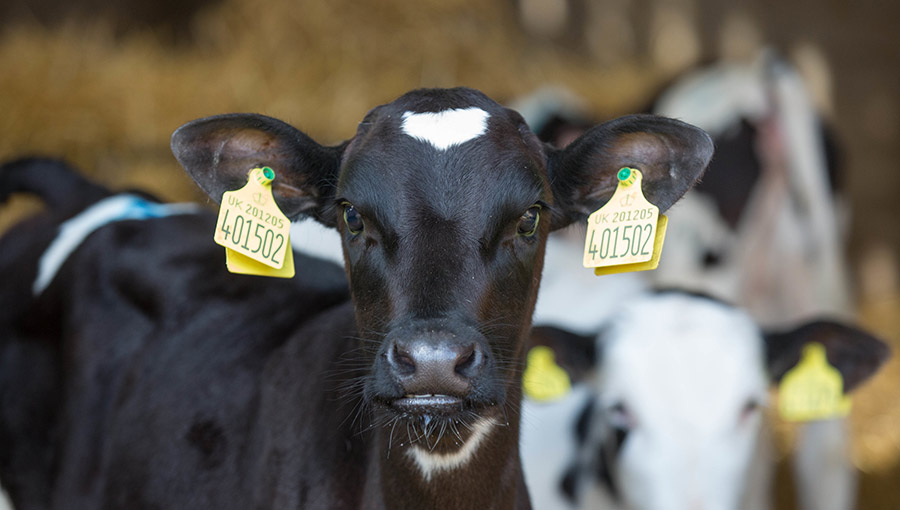How Irish dairy farmer saves €8,000 with calf-rearing method
 © Tim Scrivener
© Tim Scrivener Dairy farmers Michael and Shirley Bateman have slashed €8,000 (£7,028) off their calf-rearing bill by weaning calves off milk at six weeks of age.
Michael Bateman first saw the rearing system successfully working on a trip to Missouri in 2016 and left the farm there thinking ‘do I need to think again?’
The Batemans have expanded from 80 cows 15 years ago and are now milking 600 cows on a 207ha platform, 80% of which is leased.
They rear around 200 replacements each year and aim to hit a weaning weight of around 85kg at three months when heifers go to a contract rearer.
See also: How to assess cow efficiency with liveweight measurement
“These heifers are our next generation. They’re expensive to rear and it’s important that it’s done right and they calve early to increase genetic gain in the herd,” Mr Bateman said.
“Research shows if you’re 20kg behind at bulling weight, you lose 20kg milk solids every lactation.”
They have implemented the new calf-rearing system for the past two years.
The new system
The new system sees calves given an ad-lib concentrate ration from day one and weaned off milk at around 35 to 40 days old.
Calves are eating around 1kg of ration at four weeks and up to 3-3.5kg when they reach their weaning weight of 85-90kg at around 100 days old.
Mr Bateman summarises the rearing process:
- Calf stomach tubed with colostrum on a 3:2:1 basis. That is three litres of first colostrum within two hours of life
- Calves are grouped into pens of 10 and given access to the ad-lib concentrate ration (nut-form pellets), fresh water and ample straw bedding
- For the first four weeks, calves are fed whole milk twice daily – 2 litres in the morning and 2 litres in the evening
- At three weeks, a small amount of silage is introduced
- At six weeks calves are weaned off milk and let out to grass in groups of up to 150 with the ad-lib ration in a feeder. Calves are turned out the same day they are weaned unless the weather is extreme.
- Calves are strip grazed and given fresh grass every second day, aiming for covers of 800-1,000 DM/ha. They don’t push hard on residuals as paddocks can be tidied up at a later stage.
- The feed and water troughs are cleaned twice a week to keep fresh food and water in front of the calves all the time
- From 10 weeks of age, calves are weighed every 10 days and sent to the contract rearer if they hit weaning weight. Calves are eating around 3.5kg a day at this stage, so it is important to wean them promptly from a cost perspective
- The contract rearer provides 1.5kg a day of the same ration for two to three weeks and heifers are then on grass only until calving.
The results and finances
“My calves are definitely healthier in the last two years than they have been,” says Mr Bateman. Calves weighed an average of 205kg on 10 October 2018, which is 8kg heavier than previous years.
The target weight is 200kg before they are housed in early November and the new system has resulted in fewer calves being behind this target.
The farm’s heifer fertility rates are “as good as they have ever been”, with 92% of 2017-born heifers in-calf after six weeks.
“I’m not putting it down to the new system but it is as good as we have done before,” Mr Bateman said.
The new system has allowed the Batemans to save €40 a head when compared with the old system, based on a milk price of 40 cents/litre and ration price of 34 cents/kg:
|
|
Old system |
Old system cost |
New system |
New system cost |
|
Milk-fed |
5 litres for 70 days |
€140 |
4 litres for 35 days |
€56 |
|
Ration-fed |
0.75kg for 50 days |
€12.75 |
1 kg for 25 days and 2kg for 70 days |
€56 |
|
Total cost |
|
€152.75 |
|
€112 |
|
Saving |
|
|
|
€152-€112 = €40/calf |
Mr Bateman says his overall heifer-rearing cost is now €1,100 from birth to calving including everything except the price of the calf.
Pros and cons of the new system |
|
|
Pros |
Cons |
|
|
